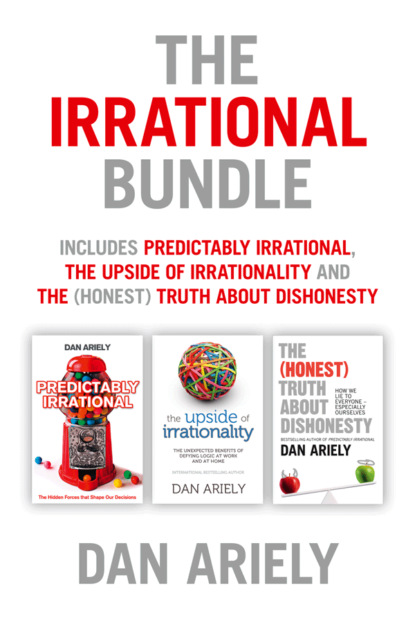По всем вопросам обращайтесь на: info@litportal.ru
(©) 2003-2024.
✖
The Irrational Bundle
Автор
Год написания книги
2018
Настройки чтения
Размер шрифта
Высота строк
Поля
Why We Can’t Make Ourselves Do
What We Want to Do
Onto the American scene, populated by big homes, big cars, and big-screen plasma televisions, comes another big phenomenon: the biggest decline in the personal savings rate since the Great Depression.
Go back 25 years, and double-digit savings rates were the norm. As recently as 1994 the savings rate was nearly five percent. But by 2006 the savings rate had fallen below zero—to negative one percent. Americans were not only not saving; they were spending more than they earned. Europeans do a lot better—they save an average of 20 percent. Japan’s rate is 25 percent. China’s is 50 percent. So what’s up with America?
I suppose one answer is that Americans have succumbed to rampant consumerism. Go back to a home built before we had to have everything, for instance, and check out the size of the closets. Our house in Cambridge, Massachusetts, for example, was built in 1890. It has no closets whatsoever. Houses in the 1940s had closets barely big enough to stand in. The closet of the 1970s was a bit larger, perhaps deep enough for a fondue pot, a box of eight-track tapes, and a few disco dresses. But the closet of today is a different breed. “Walk-in closet” means that you can literally walk in for quite a distance. And no matter how deep these closets are, Americans have found ways to fill them right up to the closet door.
Another answer—the other half of the problem—is the recent explosion in consumer credit. The average American family now has six credit cards (in 2005 alone, Americans received 6 billion direct-mail solicitations for credit cards). Frighteningly, the average family debt on these cards is about $9,000; and seven in 10 households borrow on credit cards to cover such basic living expenses as food, utilities, and clothing.
So wouldn’t it just be wiser if Americans learned to save, as in the old days, and as the rest of the world does, by diverting some cash to the cookie jar, and delaying some purchases until we can really afford them? Why can’t we save part of our paychecks, as we know we should? Why can’t we resist those new purchases? Why can’t we exert some good old-fashioned self-control?
The road to hell, they say, is paved with good intentions. And most of us know what that’s all about. We promise to save for retirement, but we spend the money on a vacation. We vow to diet, but we surrender to the allure of the dessert cart. We promise to have our cholesterol checked regularly, and then we cancel our appointment.
How much do we lose when our fleeting impulses deflect us from our long-term goals? How much is our health affected by those missed appointments and our lack of exercise? How much is our wealth reduced when we forget our vow to save more and consume less? Why do we lose the fight against procrastination so frequently?
IN CHAPTER 6 we discussed how emotions grab hold of us and make us view the world from a different perspective. Procrastination (from the Latin pro, meaning for; and cras, meaning tomorrow) is rooted in the same kind of problem. When we promise to save our money, we are in a cool state. When we promise to exercise and watch our diet, again we’re cool. But then the lava flow of hot emotion comes rushing in: just when we promise to save, we see a new car, a mountain bike, or a pair of shoes that we must have. Just when we plan to exercise regularly, we find a reason to sit all day in front of the television. And as for the diet? I’ll take that slice of chocolate cake and begin the diet in earnest tomorrow. Giving up on our long-term goals for immediate gratification, my friends, is procrastination.
As a university professor, I’m all too familiar with procrastination. At the beginning of every semester my students make heroic promises to themselves—vowing to read their assignments on time, submit their papers on time, and in general, stay on top of things. And every semester I’ve watched as temptation takes them out on a date, over to the student union for a meeting, and off on a ski trip in the mountains—while their workload falls farther and farther behind. In the end, they wind up impressing me, not with their punctuality, but with their creativity—inventing stories, excuses, and family tragedies to explain their tardiness. (Why do family tragedies generally occur during the last two weeks of the semester?)
After I’d been teaching at MIT for a few years, my colleague Klaus Wertenbroch (a professor at INSEAD, a business school with campuses in France and Singapore) and I decided to work up a few studies that might get to the root of the problem, and just maybe offer a fix for this common human weakness. Our guinea pigs this time would be the delightful students in my class on consumer behavior.
As they settled into their chairs that first morning, full of anticipation (and, no doubt, with resolutions to stay on top of their class assignments), the students listened to me review the syllabus for the course. There would be three main papers over the 12-week semester, I explained. Together, these papers would constitute much of their final grade.
“And what are the deadlines?” asked one of them, waving his hand from the back. I smiled. “You can hand in the papers at any time before the end of the semester,” I replied. “It’s entirely up to you.” The students looked back blankly.
“Here’s the deal,” I explained. “By the end of the week, you must commit to a deadline date for each paper. Once you set your deadlines, they can’t be changed.” Late papers, I added, would be penalized at the rate of one percent off the grade for each day late. The students could always turn in their papers before their deadlines without penalty, of course, but since I wouldn’t be reading any of them until the end of the semester, there would be no particular advantage in terms of grades for doing so.
In other words, the ball was in their court. Would they have the self-control to play the game?
“But Professor Ariely,” asked Gaurav, a clever master’s student with a charming Indian accent, “given these instructions and incentives, wouldn’t it make sense for us to select the last date possible?”
“You can do that,” I replied. “If you find that it makes sense, by all means do it.”
Under these conditions, what would you have done?
I promise to submit paper 1 on week ———
I promise to submit paper 2 on week ———
I promise to submit paper 3 on week ———
What deadlines did the students pick for themselves? A perfectly rational student would follow Gaurav’s advice and set all the deadlines for the last day of class—after all, it was always possible to submit papers earlier without a penalty, so why take a chance and select an earlier deadline than needed? Delaying the deadlines to the end was clearly the best decision if students were perfectly rational. But what if the students are not rational? What if they succumb to temptation and are prone to procrastination? What if they realize their weakness? If the students are not rational, and they know it, they could use the deadlines to force themselves to behave better. They could set early deadlines and by doing so force themselves to start working on the projects earlier in the semester.
What did my students do? They used the scheduling tool I provided them with and spaced the timing of their papers across the whole semester. This is fine and good, as it suggests that the students realize their problems with procrastination and that if given the right opportunities they try to control themselves—but the main question is whether the tool was indeed helpful in improving their grades. To find out about this, we had to conduct other variations of the same experiments in other classes and compare the quality of papers across the different conditions (classes).
NOW THAT I had Gaurav and his classmates choosing their individual deadlines, I went to my other two classes—with markedly different deals. In the second class, I told the students that they would have no deadlines at all during the semester. They merely needed to submit their papers by the end of the last class. They could turn the papers in early, of course, but there was no grade benefit to doing so. I suppose they should have been happy: I had given them complete flexibility and freedom of choice. Not only that, but they also had the lowest risk of being penalized for missing an intermediate deadline.
The third class received what might be called a dictatorial treatment: I dictated three deadlines for the three papers, set at the fourth, eighth, and twelfth weeks. These were my marching orders, and they left no room for choice or flexibility.
Of these three classes, which do you think achieved the best final grades? Was it Gaurav and his classmates, who had some flexibility? Or the second class, which had a single deadline at the end, and thus complete flexibility? Or the third class, which had its deadlines dictated from above, and therefore had no flexibility? Which class do you predict did worst?
When the semester was over, Jose Silva, the teaching assistant for the classes (himself an expert on procrastination and currently a professor at the University of California at Berkeley), returned the papers to the students. We could at last compare the grades across the three different deadline conditions. We found that the students in the class with the three firm deadlines got the best grades; the class in which I set no deadlines at all (except for the final deadline) had the worst grades; and the class in which Gaurav and his classmates were allowed to choose their own three deadlines (but with penalties for failing to meet them) finished in the middle, in terms of their grades for the three papers and their final grade.
What do these results suggest? First, that students do procrastinate (big news); and second, that tightly restricting their freedom (equally spaced deadlines, imposed from above) is the best cure for procrastination. But the biggest revelation is that simply offering the students a tool by which they could precommit to deadlines helped them achieve better grades.
What this finding implies is that the students generally understood their problem with procrastination and took action to fight it when they were given the opportunity to do so, achieving relative success in improving their grades. But why were the grades in the self-imposed deadlines condition not as good as the grades in the dictatorial (externally imposed) deadlines condition? My feeling is this: not everyone understands their tendency to procrastinate, and even those who do recognize their tendency to procrastinate may not understand their problem completely. Yes, people may set deadlines for themselves, but not necessarily the deadlines that are best for getting the best performance.
When I looked at the deadlines set by the students in Gaurav’s class, this was indeed the case. Although the vast majority of the students in this class spaced their deadlines substantially (and got grades that were as good as those earned by students in the dictatorial condition), some did not space their deadlines much, and a few did not space their deadlines at all. These students who did not space their deadlines sufficiently pulled the average grades of this class down. Without properly spaced deadlines—deadlines that would have forced the students to start working on their papers earlier in the semester—the final work was generally rushed and poorly written (even without the extra penalty of one percent off the grade for each day of delay).
Interestingly, these results suggest that although almost everyone has problems with procrastination, those who recognize and admit their weakness are in a better position to utilize available tools for precommitment and by doing so, help themselves overcome it.
SO THAT WAS my experience with my students. What does it have to do with everyday life? A lot, I think. Resisting temptation and instilling self-control are general human goals, and repeatedly failing to achieve them is a source of much of our misery. When I look around, I see people trying their best to do the right thing, whether they are dieters vowing to avoid a tempting dessert tray or families vowing to spend less and save more. The struggle for control is all around us. We see it in books and magazines. Radio and television airwaves are choked with messages of self-improvement and help.
And yet, for all this electronic chatter and focus in print, we find ourselves again and again in the same predicament as my students—failing over and over to reach our long-term goals. Why? Because without precommitments, we keep on falling for temptation.
What’s the alternative? From the experiments that I have described above, the most obvious conclusion is that when an authoritative “external voice” gives the orders, most of us will jump to attention. After all, the students for whom I set the deadlines—for whom I provided the “parental” voice—did best. Of course, barking orders, while very effective, may not always be feasible or desirable. What’s a good compromise? It seems that the best course might be to give people an opportunity to commit up front to their preferred path of action. This approach might not be as effective as the dictatorial treatment, but it can help push us in the right direction (perhaps even more so if we train people to do it, and give them experience in setting their own deadlines).
What’s the bottom line? We have problems with self-control, related to immediate and delayed gratification—no doubt there. But each of the problems we face has potential self-control mechanisms, as well. If we can’t save from our paycheck, we can take advantage of our employer’s automatic deduction option; if we don’t have the will to exercise regularly alone, we can make an appointment to exercise in the company of our friends. These are the tools that we can commit to in advance, and they may help us be the kind of people we want to be.
WHAT OTHER PROCRASTINATION problems might precommitment mechanisms solve? Consider health care and consumer debt.
Health Care
Everyone knows that preventive medicine is generally more cost-effective—for both individuals and society—than our current remedial approach. Prevention means getting health exams on a regular basis, before problems develop. But having a colonoscopy or mammogram is an ordeal. Even a cholesterol check, which requires blood to be drawn, is unpleasant. So while our long-term health and longevity depend on undergoing such tests, in the short term we procrastinate and procrastinate and procrastinate.
But can you imagine if we all got the required health exams on time? Think how many serious health problems could be caught if they were diagnosed early. Think how much cost could be cut from health-care spending, and how much misery would be saved in the process.
So how do we fix this problem? Well, we could have a dictatorial solution, in which the state (in the Orwellian sense) would dictate our regular checkups. That approach worked well with my students, who were given a deadline and performed well. In society, no doubt, we would all be healthier if the health police arrived in a van and took procrastinators to the ministry of cholesterol control for blood tests.
This may seem extreme, but think of the other dictates that society imposes on us for our own good. We may receive tickets for jaywalking, and for having our seat belts unsecured. No one thought 20 years ago that smoking would be banned in most public buildings across America, as well as in restaurants and bars, but today it is—with a hefty fine incurred for lighting up. And now we have the movement against trans fats. Should people be deprived of heart-clogging french fries?
Sometimes we strongly support regulations that restrain our self-destructive behaviors, and at other times we have equally strong feelings about our personal freedom. Either way, it’s always a trade-off.
But if mandatory health checkups won’t be accepted by the public, what about a middle ground, like the self-imposed deadlines I gave to Gaurav and his classmates (the deadlines that offered personal choice, but also had penalties attached for the procrastinators)? This might be the perfect compromise between authoritarianism, on the one hand, and what we have too often in preventive health today—complete freedom to fail.
Suppose your doctor tells you that you need to get your cholesterol checked. That means fasting the night before the blood test, driving to the lab the next morning without breakfast, sitting in a crowded reception room for what seems like hours, and finally, having the nurse come and get you so that she can stick a needle into your arm. Facing those prospects, you immediately begin to procrastinate. But suppose the doctor charged you an up-front $100 deposit for the test, refundable only if you showed up promptly at the appointed time. Would you be more likely to show up for the test?
What if the doctor asked you if you would like to pay this $100 deposit for the test? Would you accept this self-imposed challenge? And if you did, would it make you more likely to show up for the procedure? Suppose the procedure was more complicated: a colonoscopy, for instance. Would you be willing to commit to a $200 deposit, refundable only if you arrived at the appointment on time? If so, you will have replicated the condition that I offered Gaurav’s class, a condition that certainly motivated the students to be responsible for their own decisions.
HOW ELSE COULD we defeat procrastination in health care? Suppose we could repackage most of our medical and dental procedures so that they were predictable and easily done. Let me tell you a story that illustrates this idea.
Several years ago, Ford Motor Company struggled to find the best way to get car owners back into the dealerships for routine automobile maintenance. The problem was that the standard Ford automobile had something like 18,000 parts that might need servicing, and unfortunately they didn’t all need servicing at the same time (one Ford engineer determined that a particular axle bolt needed inspection every 3,602 miles). And this was just part of the problem: since Ford had more than 20 vehicle types, plus various model years, the servicing of them all was nearly impossible to ponder. All that consumers, as well as service advisers, could do was page through volumes of thick manuals in order to determine what services were needed.
But Ford began to notice something over at the Honda dealerships. Even though the 18,000 or so parts in Honda cars had the same ideal maintenance schedules as the Ford cars, Honda had lumped them all into three “engineering intervals” (for instance, every six months or 5,000 miles, every year or 10,000 miles, and every two years or 25,000 miles). This list was displayed on the wall of the reception room in the service department. All the hundreds of service activities were boiled down to simple, mileage-based service events that were common across all vehicles and model years. The board had every maintenance service activity bundled, sequenced, and priced. Anyone could see when service was due and how much it would cost.
But the bundle board was more than convenient information: It was a true procrastination-buster, as it instructed customers to get their service done at specific times and mileages. It guided them along. And it was so simple that any customer could understand it. Customers were no longer confused. They no longer procrastinated. Servicing their Hondas on time was easy.















